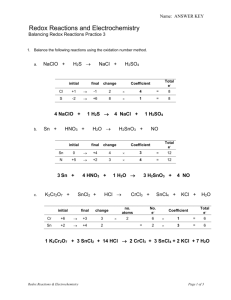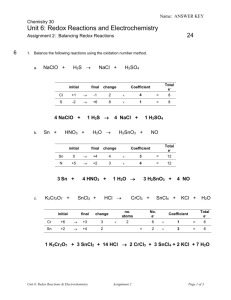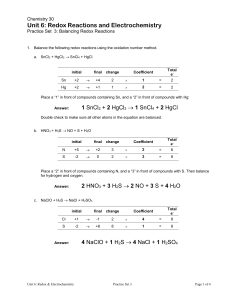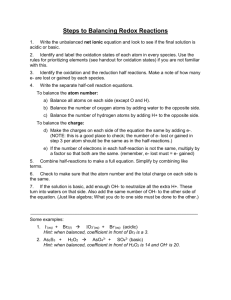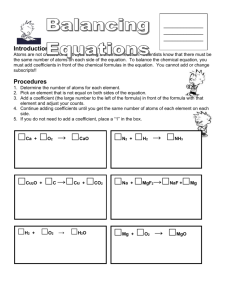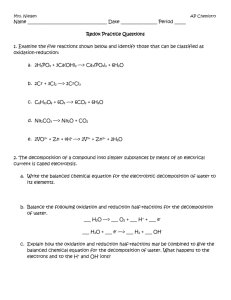Unit 6: Redox Reactions and Electrochemistry
advertisement
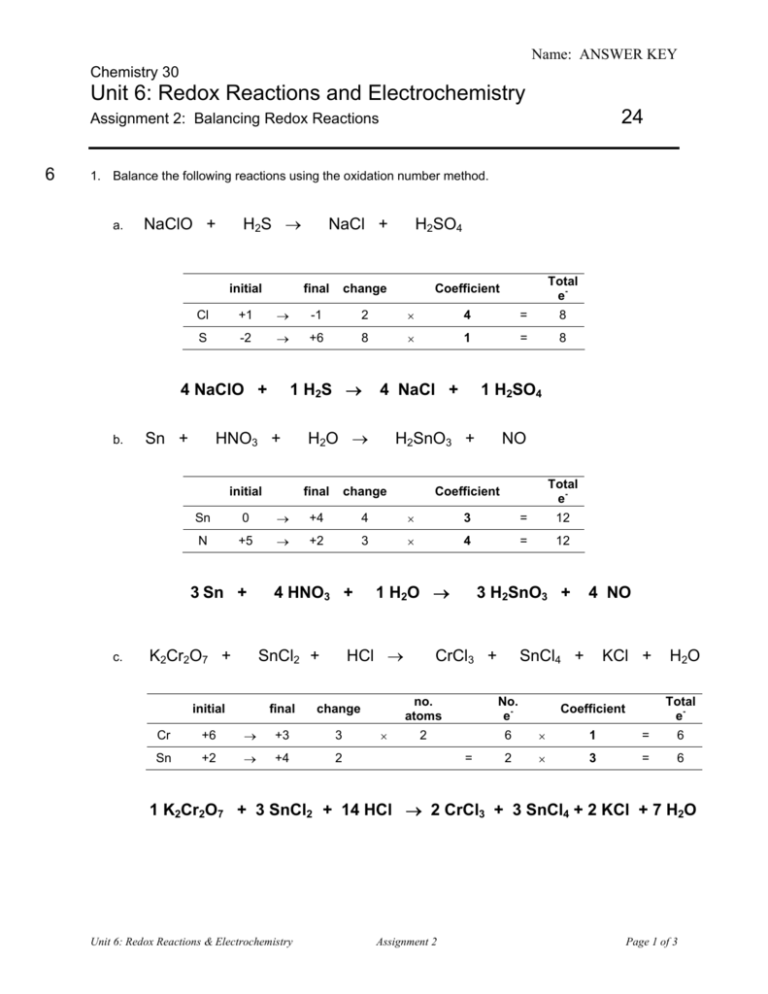
Name: ANSWER KEY Chemistry 30 Unit 6: Redox Reactions and Electrochemistry 24 Assignment 2: Balancing Redox Reactions 6 1. Balance the following reactions using the oxidation number method. a. H 2S → NaClO + initial change Total e- Coefficient +1 → -1 2 × 4 = 8 S -2 → +6 8 × 1 = 8 1 H2S → Sn + HNO3 + initial 4 NaCl + H 2O → 1 H2SO4 H2SnO3 + final change NO Total e- Coefficient Sn 0 → +4 4 × 3 = 12 N +5 → +2 3 × 4 = 12 3 Sn + c. final H2SO4 Cl 4 NaClO + b. NaCl + K2Cr2O7 + 4 HNO3 + HCl → SnCl2 + initial 1 H 2O → final change Cr +6 → +3 3 Sn +2 → +4 2 × 3 H2SnO3 + CrCl3 + 4 NO SnCl4 + KCl + H 2O no. atoms No. e- 2 6 × 1 = 6 2 × 3 = 6 = Total e- Coefficient 1 K2Cr2O7 + 3 SnCl2 + 14 HCl → 2 CrCl3 + 3 SnCl4 + 2 KCl + 7 H2O Unit 6: Redox Reactions & Electrochemistry Assignment 2 Page 1 of 3 Name: ANSWER KEY 6 2. Balance the following half-reactions. Be sure to balance for atoms first, then balance for charge by adding electrons to the appropriate side of the equation. Also identify each as either an oxidation or reduction. a. Br2 → Br – Br2 + 2 e- → 2 Br – reduction b. Fe2+ → Fe3+ Fe2+ → oxidation c. 4 → Mn2+ + H2O MnO4– + H+ Fe3+ + 1e- MnO4– + 8 H+ + 5e- → Mn2+ + 4 H2O reduction 3. Break each equation into two half-reactions. Identify each half-reaction as oxidation or reduction. a. 2 K + I2 → 2 KI 2 K → 2 K+ + 2 e- oxidation I2 + 2 e → 2 I reduction - - b. 2 Br – + F2 → Br2 + 2 F – F2 + 2 e - → 2 F– 2Br → Br2 + 2 e – 4 reduction – oxidation 4. Balance the following reactions using the half-reaction method. a. Na + Br2 → NaBr Step 1 Write the two balanced halfreactions, removing any spectator ions: Na → Na+ + 1 e– Step 2 Balance for electrons ×2 Br2 + 2 e – → 2 Br – Add the half-reactions, replacing any spectator ions that were removed and/or recombining compounds 2Na → 2Na+ + 2 e– Br2 + 2 e – → 2 Br – added together: reform compound: Unit 6: Redox Reactions & Electrochemistry Step 3 Assignment 2 2Na + Br2 → 2Na+ + 2 Br – 2 Na + Br2 → 2 NaBr Page 2 of 3 Name: ANSWER KEY b. CrO42- + H + Cl → Cr + - 3+ + Cl2 + H2O Remember to balance for atoms before adding electrons to balance for charge. Step 2 Step 1 Write the two balanced halfreactions, removing any spectator ions: Step 3 Balance Add the half-reactions, replacing any spectator ions that were removed and/or recombining compounds electrons CrO42- + 8 H+ + 3e–→ Cr3+ + 4 H2O ×2 2 CrO42- + 16 H+ + 6 e–→ 2 Cr3+ + 8 H2O 2 Cl – → Cl2 + 2 e– ×3 6 Cl – → 3 Cl2 + 6 e– added together: 4 2CrO42- + 16H+ + 6Cl – → 2Cr3+ + 3Cl2 + 8H2O 3. Balance the following reactions using either the oxidation number method or the half-reaction method. a. NO + As + H2O → N2O + HAsO2 initial final change N +2 → +1 1 As 0 → +3 3 Answer: No. e- no. atoms × 2 (in N2O) = Total e- Coefficient 2 × 3 = 6 3 × 2 = 6 6 NO + 2 As + H2O → 3 N2O + 2 HAsO2 b. Ce4+ + I– + OH– → Ce3+ + IO3– + H2O Step 2 Step 1 Write the two balanced halfreactions, removing any spectator ions: Ce4+ + 1 e– → Ce3+ Balance electrons ×6 I– + 6 OH– → IO3– + 3 H2O + 6 e– Add the half-reactions, replacing any spectator ions that were removed and/or recombining compounds 6Ce4+ + 6 e– → 6Ce3+ I– + 6 OH– → IO3– + 3 H2O + 6 e– added together: Unit 6: Redox Reactions & Electrochemistry Step 3 6 Ce4+ + I– + 6 OH– → 6 Ce3+ + IO3– + 3 H2O Assignment 2 Page 3 of 3
